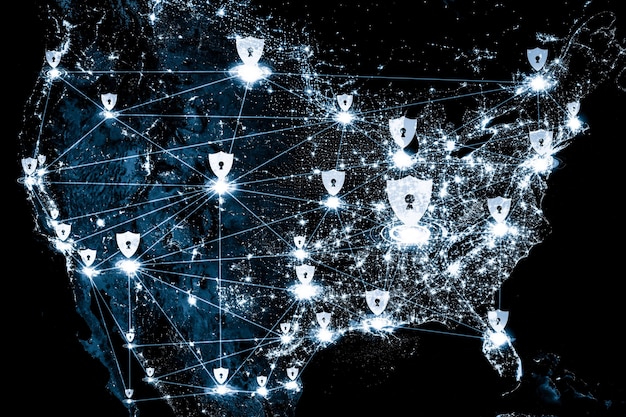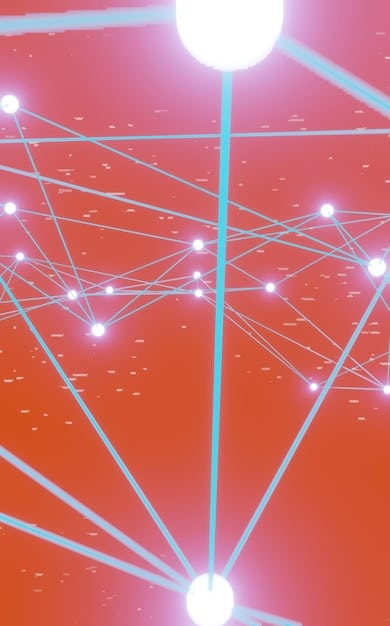Cybersecurity Policy: Protecting Critical Infrastructure from Attacks

Current cybersecurity policy protects critical infrastructure from attacks through a combination of regulatory frameworks, public-private partnerships, threat information sharing, and proactive defense measures designed to safeguard essential services and systems.
In an increasingly interconnected world, the security of critical infrastructure is paramount. How does the current cybersecurity policy protect critical infrastructure from attacks? This article explores the multifaceted approach the U.S. employs to safeguard essential services, from energy grids to communication networks, against evolving cyber threats.
Understanding the Landscape of Critical Infrastructure Cybersecurity
Critical infrastructure forms the backbone of modern society, encompassing sectors like energy, transportation, finance, and healthcare. A successful cyberattack on these systems could have devastating consequences, ranging from economic disruption to loss of life. Thus, understanding the current cybersecurity landscape is crucial.
The cybersecurity policy is not a single document, but rather a collection of laws, regulations, and best practices. These are designed to protect critical infrastructure from a variety of cyber threats, including malware, ransomware, and distributed denial-of-service (DDoS) attacks.

Key Legislation and Regulatory Frameworks
Several key pieces of legislation and regulatory frameworks form the foundation of cybersecurity policy for critical infrastructure.
- The Cybersecurity Act of 2015: This act promotes the sharing of cyber threat information between the government and the private sector, enhancing collective defense capabilities.
- The National Institute of Standards and Technology (NIST) Cybersecurity Framework: While not mandatory, it provides a voluntary framework of standards, guidelines, and best practices to manage cybersecurity-related risk.
- Sector-Specific Regulations: Various sectors have their own specific regulations, such as those from the Transportation Security Administration (TSA) for transportation systems and the Federal Energy Regulatory Commission (FERC) for the energy sector.
These frameworks and laws collectively aim to enhance the resilience of critical infrastructure by establishing standards, encouraging information sharing, and promoting proactive security measures.
In conclusion, the current landscape of critical infrastructure cybersecurity is shaped by a complex interplay of regulations, frameworks, and collaborative efforts aimed at mitigating cyber risks and ensuring the continuity of essential services.
The Role of Government Agencies in Cybersecurity
Government agencies play a pivotal role in protecting critical infrastructure from cyberattacks. Several agencies are involved, each with its own specific responsibilities. Understanding this structure is crucial for grasping how the cybersecurity policy functions.
These agencies work together to provide a comprehensive defense against cyber threats, from threat intelligence gathering to incident response.
Key Government Agencies and Their Responsibilities
Here are some of the key government agencies involved in critical infrastructure **cybersecurity**:
- The Cybersecurity and Infrastructure Security Agency (CISA): This agency is the lead federal agency for cybersecurity and infrastructure security, working to enhance the security and resilience of the nation’s critical infrastructure.
- The Federal Bureau of Investigation (FBI): The FBI investigates cybercrimes and works to disrupt cyber threats targeting critical infrastructure.
- The National Security Agency (NSA): The NSA provides technical expertise and intelligence to protect national security systems and critical infrastructure.
Public-Private Partnerships
A key aspect of the government’s role is fostering public-private partnerships. These partnerships allow government agencies and private sector entities to share information and resources, enhancing collective defense capabilities.
These partnerships facilitate real-time threat information sharing and collaborative incident response, thereby enhancing the security posture of critical infrastructure. The government also offers resources and guidance to help private sector entities improve their cybersecurity practices.

In summary, government agencies lead the charge in protecting critical infrastructure from cyberattacks, with CISA, FBI, and NSA playing key roles. Public-private partnerships further strengthen these efforts, fostering collaboration and information sharing.
Analyzing Key Components of Current Cybersecurity Policy
Several key components make up the current cybersecurity policy. These components are designed to work together to provide a layered defense against cyber threats.
By examining these key components, we can gain a deeper understanding of how the cybersecurity policy works.
Risk Management Frameworks
Risk management frameworks are a cornerstone of cybersecurity policy. These frameworks provide a structured approach to identifying, assessing, and mitigating cyber risks.
- NIST Cybersecurity Framework: This framework offers a flexible and adaptable approach to managing cybersecurity risks. It is widely used by organizations of all sizes and across various sectors.
- ISO 27001: This international standard provides a comprehensive set of security controls for managing information security risks.
- Critical Infrastructure Sectors: Certain critical infrastructure sectors have their own regulatory bodies that oversee that cybersecurity compliance and best practices
Ultimately, effective risk management is essential for protecting critical infrastructure from cyberattacks.
Addressing Emerging Threats and Vulnerabilities
The cybersecurity landscape is constantly evolving, with new threats and vulnerabilities emerging all the time. It is crucial that cybersecurity policy is able to adapt to these changes.
Addressing these emerging threats requires continuous monitoring, adaptation, and innovation.
Evolving Cyber Threats
Cyber threats are becoming increasingly sophisticated and targeted, posing a persistent danger to critical infrastructure.
- Ransomware Attacks: These attacks encrypt critical data and demand a ransom for its release.
- Supply Chain Vulnerabilities: These vulnerabilities exploit weaknesses in the supply chain to compromise critical systems.
- IoT Devices: The proliferation of IoT devices introduces new attack vectors and vulnerabilities.
Effective strategies to counter these evolving threats include proactive threat hunting, robust incident response plans, and continuous security awareness training.
In light of the ever-changing threat landscape, cybersecurity policies must remain adaptable and proactive, incorporating the latest threat intelligence and security best practices.
Evaluating the Effectiveness of Cybersecurity Policy
The effectiveness of cybersecurity policy is a critical question. Are current policies and practices actually protecting critical infrastructure from cyberattacks?
Evaluating effectiveness requires a multifaceted approach, considering various metrics and assessing the impact of policy on real-world outcomes.
Metrics for Measuring Effectiveness
Several metrics can be used to measure the effectiveness of **cybersecurity** policy:
- Reduction in Cyber Incidents: A decrease in the number and severity of cyber incidents targeting critical infrastructure
- Faster Incident Response: Improved incident response times and reduced downtime
- Enhanced Threat Information Sharing: Increased participation in threat information sharing programs
Regular assessments and audits are essential for evaluating the effectiveness of cybersecurity policies and identifying areas for improvement. It is important to ensure that we have the capabilities to effectively protect the systems vital to daily life.
Future Directions in Cybersecurity Policy
Looking ahead, what are the future directions in cybersecurity policy? How can we ensure that policies remain effective in the face of evolving threats and technologies?
Adaptability, innovation, and collaboration will be key to navigating the future of cybersecurity policy.
Emerging Technologies and Policy Implications
Emerging technologies are transforming the cybersecurity landscape and have implications for policy development:
- Artificial intelligence (AI): AI can automate threat detection and response, but also introduces new risks if it is compromised
- Quantum Computing: Quantum computing could break existing encryption algorithms, requiring new cryptographic solutions
- 5G and Wireless Communication: 5G and similar technologies expand the attack surface and introduce new vulnerabilities
By anticipating and addressing these challenges, policymakers can ensure that cybersecurity policy remains effective in the face of emerging technologies.
| Key Aspect | Brief Description |
|---|---|
| 🛡️ Regulatory Frameworks | Laws and regulations establishing cybersecurity standards and practices. |
| 🤝 Public-Private Partnerships | Collaborative efforts between government and private sectors for information sharing. |
| 🚨 Threat Intelligence | Gathering and analysis of cyber threat information to inform defensive measures. |
| 🚀 Future Directions | Adapting to emerging technologies like AI and quantum computing. |
Frequently Asked Questions (FAQ)
▼
Critical infrastructure includes systems and assets vital to the United States, such as energy grids, water supplies, communication networks, and transportation systems. These are essential for national security and economic stability.
▼
CISA, the Cybersecurity and Infrastructure Security Agency, enhances the security and resilience of U.S. infrastructure. It offers tools, training, and resources to protect against cyber and physical threats, working closely with stakeholders.
▼
These partnerships involve collaboration between government agencies and private sector entities. They share information and resources to enhance collective defense capabilities, facilitating real-time threat information sharing.
▼
The NIST Cybersecurity Framework provides a voluntary set of standards, guidelines, and best practices for managing cybersecurity-related risks. It helps organizations identify, protect, detect, respond to, and recover from cyberattacks.
▼
Organizations can improve by implementing risk management frameworks, conducting regular security assessments, training employees, and staying informed about emerging threats. Public-private partnerships are essential as well, to effectively strengthen posture.
Conclusion
The current cybersecurity policy plays a crucial role in protecting critical infrastructure from attacks. By understanding the key components of this policy, addressing emerging threats, and continuously evaluating effectiveness, we can work to ensure the security and resilience of the systems that underpin modern society.





